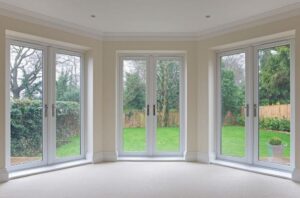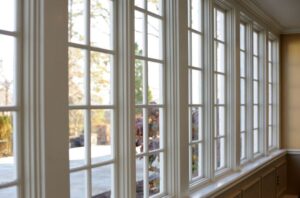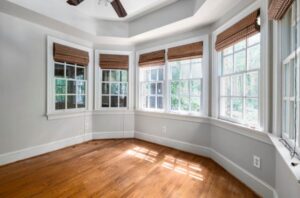When it comes to enhancing your home’s comfort and aesthetic, the choice between Hayfield windows vs Pella windows is more than just a matter of preference; it’s a decision that shapes your living space.
Hayfield, with its focus on vinyl windows, and Pella, known for its fiberglass and broader material range, both bring unique offerings to the table. The significance of this choice extends beyond mere appearance or cost. It plays a crucial role in energy efficiency, maintenance, and even the overall ambiance of your home.
Our comprehensive comparison aims to simplify this decision, laying out the strengths and differences of each brand, to guide you in selecting the window that not only meets your practical needs but also complements your home’s character.
Quick Comparison
| Feature | Hayfield Windows | Pella Windows |
|---|---|---|
| Material | Primarily vinyl | Emphasizes fiberglass; offers wood, fiberglass, vinyl |
| Quality | Standard quality | Premium quality |
| Design Variety | Limited design options | Wide range of designs and styles |
| Durability | Decent durability | Superior durability and construction |
| Cost | Budget-friendly | Generally more expensive |
| Frame Materials | Vinyl and some other options | Broad range: wood, fiberglass, vinyl |
| Glass Options | Standard, tinted, Low-E glass | Advanced Low-E, Argon gas-filled glass |
| Certifications | Energy Star certified | Energy Star, Best for Kids Certified |
| Energy Efficiency | U-Factor: 0.25, Solar Heat Gain: 0.29 | U-Factor: 0.27, Solar Heat Gain: 0.21 |
| Technology & Engineering | BetterVue Mesh Screen, ClimaGuard 72/57 Glass | ThermoPlastic Vulcanizate Seals |
| Maintenance & Installation | Easy cleaning and installation | Easy cleaning, certified installer for installation |
| Sound Insulation | Good | Superior, with options like triple-pane glass |
| Warranty | Limited lifetime warranty | Limited lifetime warranty |
| Price Range | Windows: $500-$1500, Doors: $800-$4000 | Windows: $250-$1000, Doors: $850-$3400 |
| Additional Features | Natural light, multipoint lock, optional brick mold | Contemporary designs, patented lock, commercial-grade strength |
Detailed Comparison Between Hayfield and Pella Windows
In our exploration of Hayfield windows vs Pella windows, the focus is not only on what meets the eye but also on what lies beneath the surface.
This detailed comparison digs into the material quality, design, durability, and the technical specifications of both brands.
Material and Quality: Vinyl Focus of Hayfield vs. Fiberglass Emphasis by Pella
Hayfield’s specialty in vinyl windows offers ease in installation and maintenance. Though their appearance may not be as polished, their functionality is noteworthy.
Pella, on the other hand, leans towards fiberglass, known for its aesthetic appeal. This material choice not only enhances the look but may require more upkeep.
- Standard vs. Premium Quality
- Hayfield caters to a more standard quality level, making it a practical choice for average households.
- Pella steps up the game with premium quality materials, delivering an upscale feel to homes.
Design, Durability, and Cost: Comparing Key Aspects
The window design can significantly impact your home’s overall look and feel.
- Design Options: Limited vs. Diverse
- Hayfield offers limited design choices, focusing more on functionality.
- Pella provides a wider variety of designs, catering to diverse aesthetic preferences.
- Comparing Durability: Decent vs. Superior
- Hayfield windows possess decent durability.
- Pella’s windows, known for their superior durability, boast heavy-duty construction.
- Cost Analysis: Budget-Friendly vs. Upscale
- Hayfield is more budget-friendly, offering reasonable pricing.
- Pella, with its high-quality materials, generally comes with a higher price tag.
Technical Specifications and Features: What Sets Them Apart
Exploring deeper into the technical realm reveals more about each brand’s strengths.
- Frame Materials: Vinyl and Others vs. Broad Range
- Hayfield provides vinyl and some other material options.
- Pella offers a broader spectrum, including wood, fiberglass, and vinyl.
- Glass Options: Standard and Specialized vs. Advanced Technological
- Hayfield has standard glass options like tinted and Low-E glass for energy efficiency.
- Pella steps ahead with advanced technology in glass, featuring Low-E glazing and Argon gas-filled options.
- Energy Efficiency Ratings: U-Factor and Solar Heat Gain
- Hayfield has a U-Factor of 0.25 and a Solar Heat Gain Coefficient (SHGC) of 0.29.
- Pella’s windows come with a U-Factor of 0.27 and SHGC of 0.21, indicating better energy performance.
This comprehensive breakdown provides a clearer perspective on choosing between Hayfield and Pella windows, considering your specific needs and preferences.
Evaluating Which Brand is Better for Your Needs
Deciding between Hayfield windows vs Pella involves considering how each brand’s features align with your specific requirements.
This section delves into the performance, technology, maintenance, installation, and other critical factors to help you make an informed decision.
Performance and Technology: Advanced Technologies for Modern Homes
The technological advancements in windows can significantly impact their performance and your comfort.
- Technology & Engineering
- Hayfield features the BetterVue Mesh Screen Technology and ClimaGuard 72/57 Glass, enhancing visibility and energy efficiency.
- Pella employs ThermoPlastic Vulcanizate (TPV) Seals, offering superior insulation and durability.
- Maintenance and Installation
- Hayfield offers ease of cleaning and straightforward installation, catering to DIY enthusiasts.
- Pella provides certified installation services, ensuring professional fitting and long-term reliability.
Additional Considerations: Beyond the Basics
Other factors like sound insulation, warranty, and price range also play a crucial role in the decision-making process.
- Sound Insulation Capabilities
- Hayfield provides good sound insulation, a feature essential for urban settings.
- Pella offers superior sound resistance, with options like triple-pane glass enhancing soundproofing.
- Warranty and Price Range Comparison
- Both brands offer limited lifetime warranties, assuring long-term investment protection.
- Price Range:
- Hayfield: Windows range from $500 to $1500, Doors from $800 to $4000.
- Pella: Windows are priced between $250 and $1000, Doors between $850 and $3400.
Unique Features and Certifications: What Sets Each Apart
Unique features and certifications can be the deciding factors for some homeowners.
- Additional Features
- Hayfield boasts classic views for more natural light, a multipoint locking system, and optional built-in brick mold.
- Pella offers contemporary designs, a patented lock system, and commercial-grade strength.
- Certifications
- Both brands are Energy Star certified, ensuring energy efficiency.
- Pella additionally holds the Best for Kids Certification, making it a safer choice for families.
These detailed insights into Hayfield and Pella windows aim to assist you in choosing the brand that best suits your lifestyle, aesthetic preferences, and functional requirements.
Conclusion: Selecting the Ideal Window Brand
As we wrap up our comparison of Hayfield windows vs Pella windows, it’s clear that both brands offer distinct advantages.
Hayfield shines with its budget-friendly, durable vinyl options, suitable for standard needs. Pella, on the other hand, stands out with its premium quality, diverse designs, and advanced technological features, catering to more upscale requirements.
Ultimately, the decision boils down to what aligns best with your specific needs, preferences, and budget. By considering the key aspects we’ve discussed, homeowners can make smart, informed choices, ensuring their window selection enhances both the functionality and aesthetics of their homes.





